Gender Bender and Crossdresser: Understanding the Difference
Gender identity has come in handy to enable people to understand and accept this fast change, leading to the emergence of terms such as crossdresser and gender benders.
Although these terms may look the same, they denote various notions altogether.
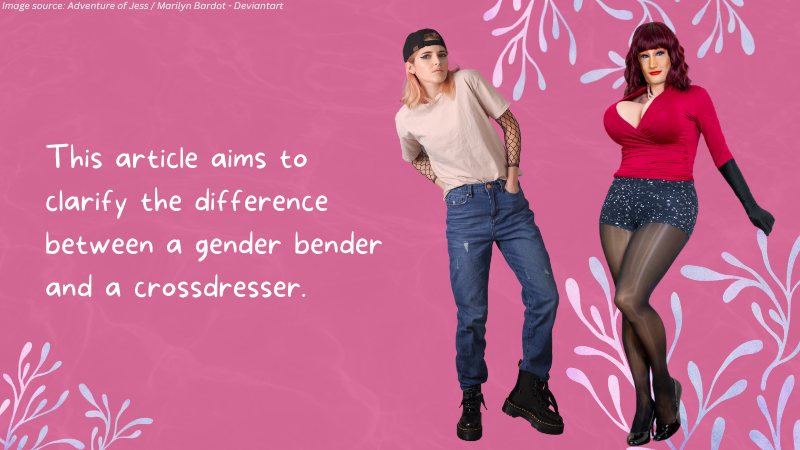
This article aims to clarify the difference between a gender bender and a crossdresser, dissecting their definitions, motivations, and intents and exploring their cultural and social implications.
Gender Bender
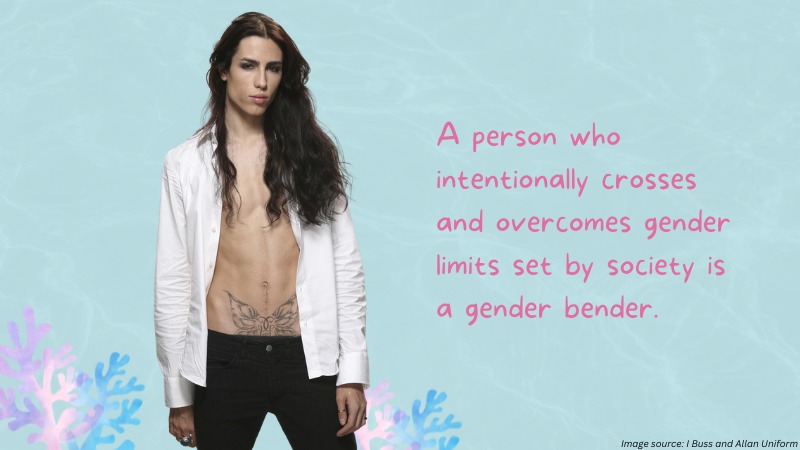
It is essential to start with an appreciation of what each of these terms means.
A person who intentionally crosses and overcomes gender limits set by society is a gender bender.
It may be wearing clothes that are traditionally associated with the other gender, assuming particular manners of dressing or behavior, or manifest using makeup and facial reconstruction surgery.
There are gender benders who have the complete characteristics of both genders.
Others shift between masculine and feminine roles within a particular situation.
Crossdresser
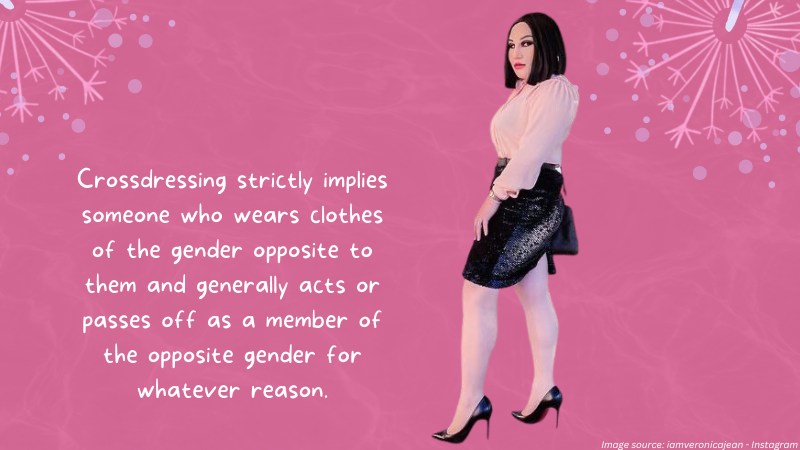
However, crossdressing strictly implies someone who wears clothes of the gender opposite to them and generally acts or passes off as a member of the opposite gender for whatever reason, be it self-gratification, entertainment, or self-expression.
Some crossdressers identify strongly with their assigned sex upon birth and enjoy wearing dresses because it gives them newfound freedom or pleasure.
On the other hand, crossdressing is often about enjoying yourself by dressing up in the clothes commonly worn by the other sex.
Difference between Gender Bender and Crossdresser
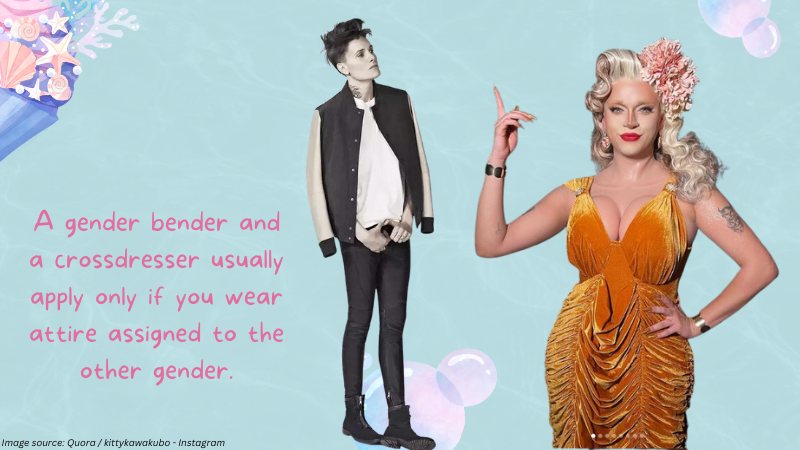
A gender bender and a crossdresser usually apply only if you wear attire assigned to the other gender.
However, there are several distinctions between these terms, such as:
The Motivation and Intent
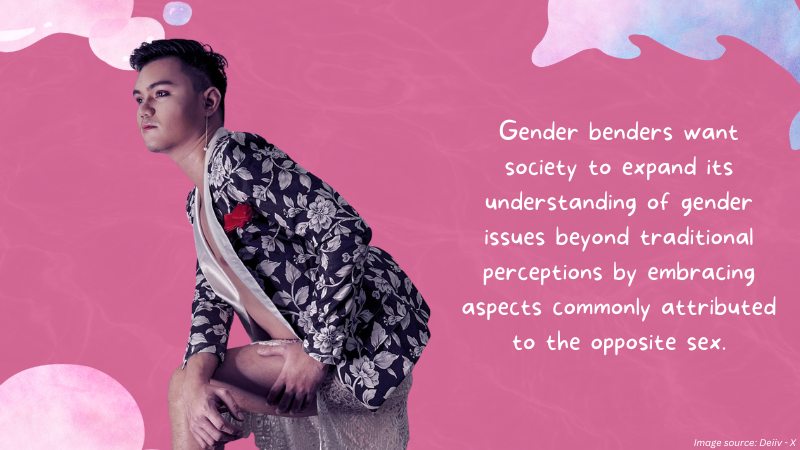
The reason for engaging in gender-bending or crossdressing is typically unique to each individual.
Gender benders do so to challenge and dispel what appears to be a two-dimensional notion of being either male or female.
Society is supposed to expect people to behave and appear in a particular manner, depending on the sex they belong to, and individuals are expected to feel confined and limited due to the pressure that comes with the set definitions.
Therefore, gender benders want society to expand its understanding of gender issues beyond traditional perceptions by embracing aspects commonly attributed to the opposite sex.
However, a different reason for crossdressing is individual gratification, fun, and self-expression.
Crossdressing lets you express other aspects of your identities, contradicting societal norms.
It allows you to be true to yourself and escape societal gender expectations, albeit for a short period.
Crossdressing might help you discover some hidden or unknown elements of your personality, that you usually keep out of your daily life.
Frequency

Frequency refers to how frequently an individual engages in a particular activity or behavior.
It is an essential element that sets these concepts apart as they regard gender bending and crossdressing in context.
It is not unusual for the gender benders to be dressed in manners challenging societal gender rules.
This may mean that they will often dress, act, and express unconventionally, embracing the fluidity of their identity.
Their gender expression becomes essential in their daily activities, and they try to escape society’s constraints.
However, crossdressing may also happen intermittently or inconsistently, especially for those who do not do it daily.
This can be inspired by specific needs and choices or on special occasions.
However, crossdressers may wear attire ordinarily associated with the opposite gender when attending specific functions or events and because of personal preference, but only for a selected period.
Identity vs. Expression
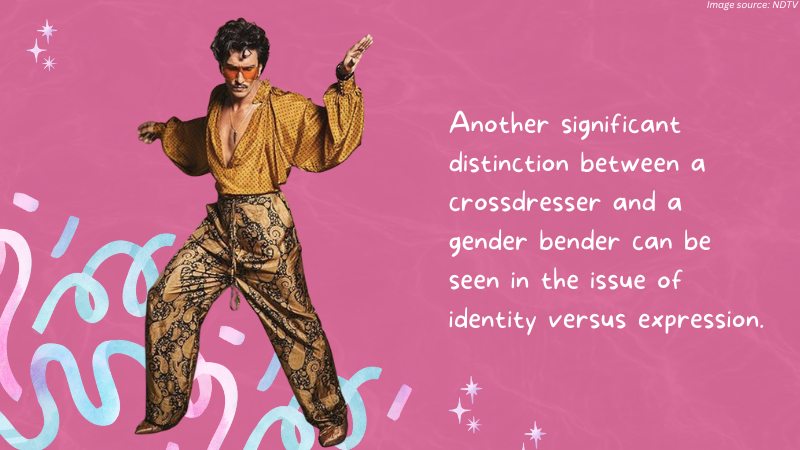
Another significant distinction between a crossdresser and a gender bender can be seen in the issue of identity versus expression.
A gender bender can be genderqueer, non-binary, or express a personal understanding of their gender.
The appearance they present themselves with is a means through which they express their gender as an aspect of their personality.
However, crossdressers usually associate with the sex of the individuals assigned at birth, although they wish to showcase clothes that pertain to an alternative sex.
Social acceptance

Social acceptance is essential in the lives of gender benders since such people are sometimes disadvantaged when they do not conform to what society considers as regular gender expression.
Society finds it hard to accept individuals who go against the typical gender roles since this practice has been strictly followed.
Transgender people are some forms of gender bender who can suffer a kind of discrimination.
They face many challenges in education, employment, health care, and other areas of their life.
However, failing to accept them results in more psychological illnesses that adversely affect their general quality of life.
Crossdressers also face discrimination, though not as much since usually, society views this as an individual’s preference or even a fetish.
However, since they are not regarded as having transgressed the prescribed behavior of men and women, it makes them less of a gender bender.
With every social advancement, it is vital to create a space that supports multiple gender expressions.
Education on gender identity and challenging stereotypical notions can encourage appreciation of others’ experiences with different expressions of gender, fostering an open-minded and tolerant community for every person irrespective of their gender mannerisms.
Psychological Aspect
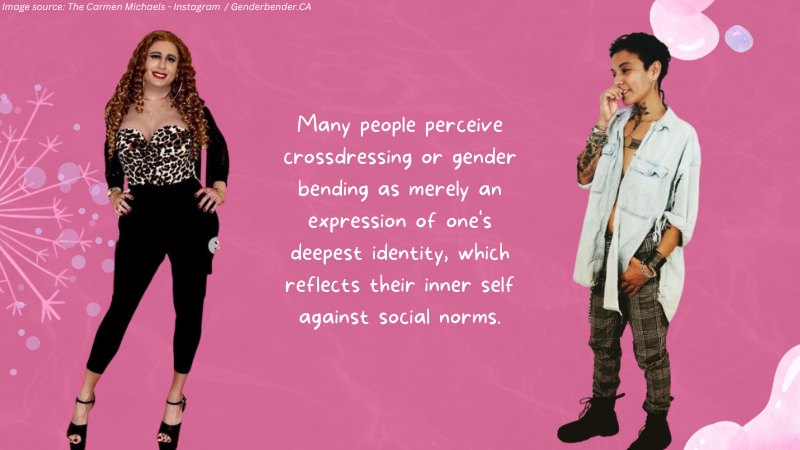
The psychological difference also separates gender benders from crossdressers.
Many people perceive crossdressing or gender bending as merely an expression of one’s deepest identity, which reflects their inner self against social norms.
The psychological component of crossdressing is more often due to personal expression, comfort, or sexual pleasure with no intention of changing someone’s gender.
Cultural and Social Implications of Gender Bender and Crossdressers
These practices have had different societal implications over the years and in different parts of the world.
Concerning gender-bending and crossdressing, some aspects of culture include:
Expression of Gender Identity
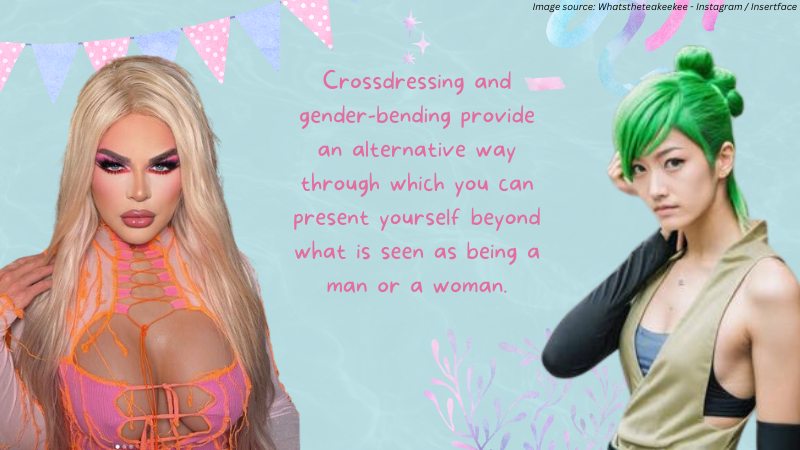
Crossdressing and gender-bending provide an alternative way through which you can present yourself beyond what is seen as being a man or a woman.
Such a manner of self-awareness questions the very tight rules of society, which are used to define identities based on sex at birth only.
Acceptance of a gender bender and crossdressing allows you to find yourself, recognize your identity, and create more tolerant thinking about sexual orientation diversification.
Breaking Stereotypes
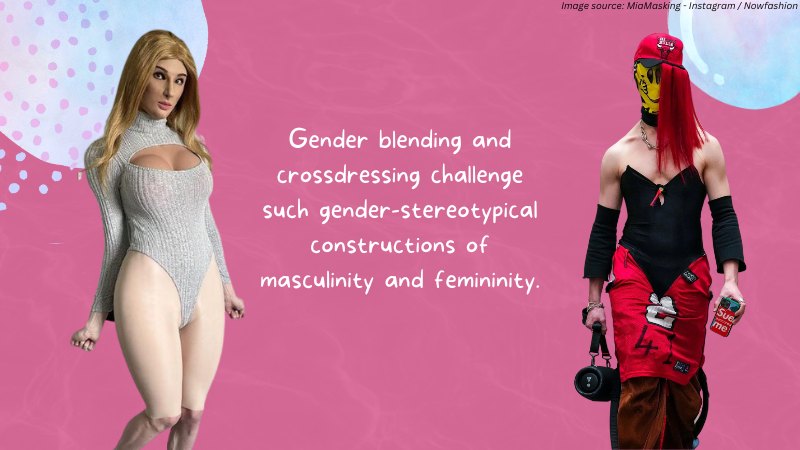
Gender blending and crossdressing challenge such gender-stereotypical constructions of masculinity and femininity.
In this way, people question that only specific dresses or ways of dressing can be attributed to a particular sex.
The practices provide openness towards individual expressions that transcend society’s expectations and lead to broadening acceptance of many gender expressions.
Artistic Expression
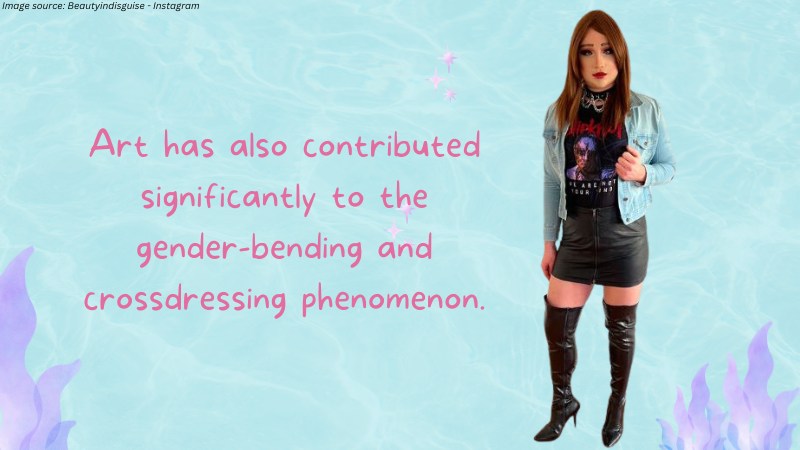
Art has also contributed significantly to the gender-bending and crossdressing phenomenon.
These practices can be an art that extends beyond theatrical performances and drag shows to disrupt and reconstruct society’s stories.
In their performances, artists engaged in gender-bending and crossdressing questioned societal expectations and gender stereotypes and created grounds for debates on identity and gender characteristics.
LGBTQ+ Visibility and Acceptance
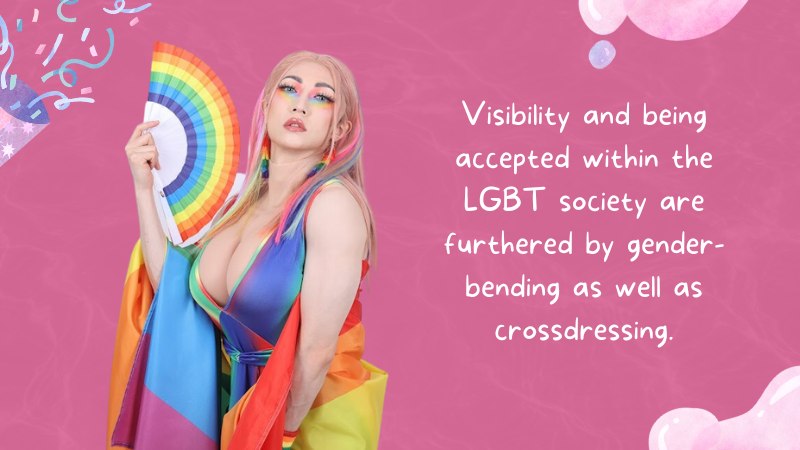
Visibility and being accepted within the LGBT society are furthered by gender-bending as well as crossdressing.
For centuries, such activities were predominantly linked with the gay population, and they afforded homosexuals the opportunity to try out new sexual roleplaying models.
Society gets accustomed to other gender expressions, such as gender bending and crossdressing, and it becomes more tolerant by accommodating LGBTQ+ people.
Political Activism
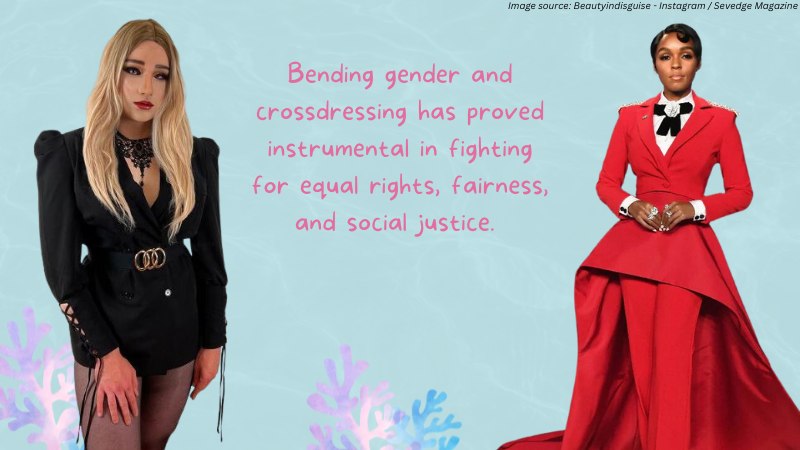
Bending gender and crossdressing has proved instrumental in fighting for equal rights, fairness, and social justice.
Such acts are weapons with which people express their oppression because of non-traditional sexual behaviors.
Gender benders and crossdressers make their visibility work for them to bring about changes on the ground by advocating for equal rights and condemning social inequalities.
Preservation of Cultural Traditions
Some cultures have integrated gender-bending or crossdressing into their typical cultural traditions, like rituals and ceremonies.
In turn, these practices have played as a way of challenging the sex roles, defying the boundaries, and crossing societal standards.
These cultural traditions may be preserved and celebrated, allowing society to recognize that gender identity is a fluid concept and not a static definition.
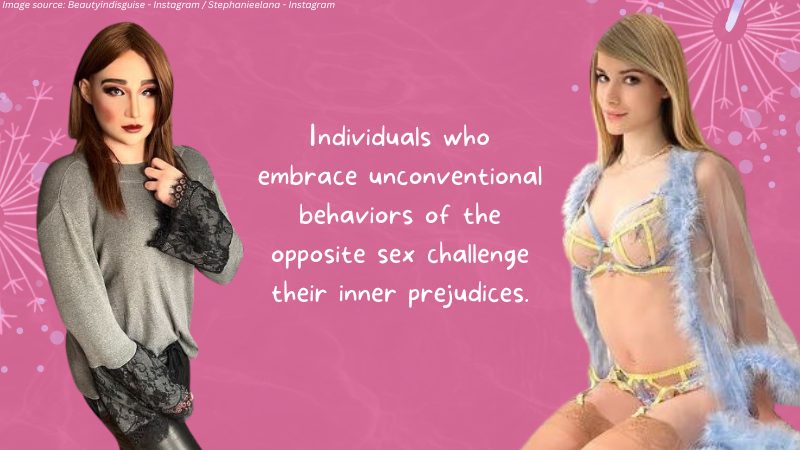
Personal Empowerment and Confidence
Practices such as gender bending and crossdressing may provide a sense of empowerment and lead to higher confidence levels for some people.
Individuals who embrace unconventional behaviors of the opposite sex challenge their inner prejudices.
They use this exploration to find who they are so that they can appreciate themselves through which their self-esteem grows.
Conclusion
Gender benders and crossdressers differ regarding their motivations, intentions, and how society perceives gender roles and identities.
Gender benders desire to change and reshape how society sees gender.
At the same time, crossdressers prefer it for their enjoyment, fun, or some sense of expression by reversing the roles of men and women temporarily through clothes.
The cultural and social implications of gender bends, and crossdressers are distinct but lag, advancing the appreciation of gender identity within societies.
Therefore, nurturing an understanding and compassionate society is essential as these discussions on gender change create a community that celebrates human diversity.
- Who is Bobrisky? Everything About the Nigerian Crossdresser
- 7 Signs that You are a Sissy Slut
- The Crossdressers Forum: Your Go-To Place for All Things Crossdressing
- How to Use a Strap On Vagina for a Beginner Crossdresser
- 5 Best Ladyboy Go-Go Bars in Bangkok
- Step-by-Step Guide to Becoming a Professional Transgender Dominatrix
Established in 2009, We are a recognized manufacturer and seller of professional crossdressing products.
It is our aim to become not just the most creative manufacturer but also a very considerate seller, as we provide the best quality products for crossdressers all around the world.












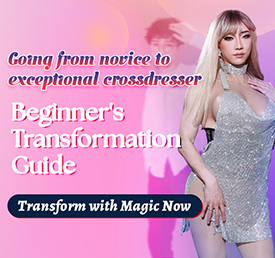









 Breast Forms
Breast Forms  Body Suit
Body Suit  Realistic Mask
Realistic Mask  Femini Girdle
Femini Girdle Hip & Butt Enhancement (8)
Hip & Butt Enhancement (8) Penis Prosthesis
Penis Prosthesis Fake Muscle
Fake Muscle Bikini
Bikini  Wig
Wig  Corsets
Corsets Course
Course service@roanyer.com
service@roanyer.com +8618652200711
+8618652200711 Facebook
Facebook YouTube
YouTube Twitter
Twitter Instagram
Instagram




